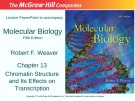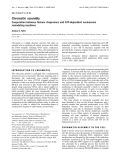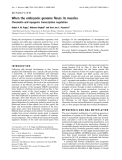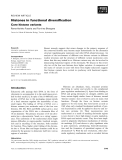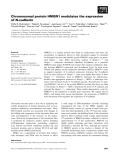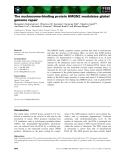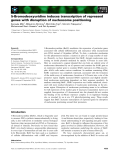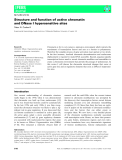
Nucleosome structure
-
Chapter 13 - Chromatin structure and its effects on transcription. In this chapter, we will look at the crucial relationship among activators, chromatin structure, and gene activity. This chapter presents the following content: Histones, nucleosomes, chromatin structure and gene activity.
 40p
40p  tangtuy05
tangtuy05
 30-03-2016
30-03-2016
 77
77
 3
3
 Download
Download
-
Chromatin is a highly dynamic structure that plays an essential role in regulating all nuclear processes that utilize the DNA template including DNA repair, replication, transcription and recombination. Thus, the mechanisms by which chromatin structures are assembled and modified are questions of broad interest. This minireview will focus on two groups of proteins: (a) histone chaperones and (b) ATPdependent chromatin remodeling machines, that co-operate to assemble DNA and histone proteins into chromatin....
 7p
7p  research12
research12
 01-06-2013
01-06-2013
 32
32
 4
4
 Download
Download
-
During the development of multicellular organisms, both transient and stable gene expression patterns have to be established in a precisely orchestrated sequence. Evidence from diverse model organisms indicates that this epigenetic program involves not only transcription factors, but also the local structure, composition, and modification of chromatin, which define and maintain the accessibility and transcriptional competence of the nucleosomal DNA template.
 6p
6p  research12
research12
 01-06-2013
01-06-2013
 33
33
 4
4
 Download
Download
-
Recent research suggests that minor changes in the primary sequence of the conserved histones may become major determinants for the chromatin structure regulating gene expression and other DNA-related processes. An analysis of the involvement of different core histone variants in different nuclear processes and the structure of different variant nucleosome cores shows that this may indeed be so. Histone variants may also be involved in demarcating functional regions of the chromatin.
 20p
20p  fptmusic
fptmusic
 12-04-2013
12-04-2013
 38
38
 4
4
 Download
Download
-
HMGN1 is a nuclear protein that binds to nucleosomes and alters the accessibility of regulatory factors to their chromatin targets. To elucidate its biological function and identify specific HMGN1 target genes, we gener-ated Hmgn1–⁄– mice. DNA microarray analysis of Hmgn1+⁄+ and Hmgn1–⁄– embryonic fibroblasts identified N-cadherin as a potential HMGN1 gene target.
 11p
11p  dell39
dell39
 27-03-2013
27-03-2013
 34
34
 3
3
 Download
Download
-
The folding of eukaryotic DNA into the 30 nm fibre comprises the first level of transcriptionally dormant chromatin. Understanding its structure and the processes of its folding and unfolding is a prerequisite for under-standing the epigenetic regulation in cell differentiation.
 11p
11p  galaxyss3
galaxyss3
 07-03-2013
07-03-2013
 36
36
 5
5
 Download
Download
-
The HMGN family comprises nuclear proteins that bind to nucleosomes and alter the structure of chromatin. Here, we report that DT40 chicken cells lacking eitherHMGN2orHMGN1a, or lacking both HMGN1aand HMGN2, are hypersensitive to killing by UV irradiation. Loss of both HMGN1aand HMGN2or only HMGN2increases the extent of UV-induced G2 –M checkpoint arrest and the rate of apoptosis.
 12p
12p  viettel02
viettel02
 20-02-2013
20-02-2013
 37
37
 2
2
 Download
Download
-
5-Bromodeoxyuridine (BrdU) modulates the expression of particular genes associated with cellular differentiation and senescence when incorporated into DNA instead of thymidine (dThd). To date, a molecular mechanism for this phenomenon remains a mystery in spite of a large number of stud-ies.
 10p
10p  viettel02
viettel02
 19-02-2013
19-02-2013
 37
37
 3
3
 Download
Download
-
About a decade ago, the elastic properties of a single chromatin fiber and, subsequently, those of a single nucleosome started to be explored using optical and magnetic tweezers. These techniques have allowed direct mea-surements of several essential physical parameters of individual nucleo-somes and nucleosomal arrays, including the forces responsible for the maintenance of the structure of both the chromatin fiber and the individual nucleosomes
 13p
13p  cosis54
cosis54
 05-01-2013
05-01-2013
 37
37
 4
4
 Download
Download
-
Chromatin is by its very nature a repressive environment which restricts the recruitment of transcription factors and acts as a barrier to polymerases. Therefore the complex process of gene activation must operate at two levels. In the first instance, localized chromatin decondensation and nucleosome displacement is required to make DNA accessible.
 29p
29p  cosis54
cosis54
 05-01-2013
05-01-2013
 48
48
 5
5
 Download
Download
CHỦ ĐỀ BẠN MUỐN TÌM








